
|
This article or section needs to be cleaned up to reach a higher standard of article quality.
Please follow the guidelines of our manual of style and complete this article to a higher level of quality. When this is done, this message may be removed. |
| 2 mark | |||
|---|---|---|---|

| |||
| Coin from 1905 | |||
| General information | |||
| Country | |||
| Value |
ℳ2.00 | ||
| Years |
| ||
| Measurements and composition | |||
| Mass |
11.111 g[1] | ||
| Diameter |
28 mm[1] | ||
| Thickness |
2 mm[1] | ||
| Composition |
silver[1] | ||
| Appearance | |||
| Shape |
round | ||
| Alignment |
medallic | ||
| Obverse |
| ||
| Reverse |
Reichsadler, state title, value, year[1] | ||
| v · d · e | |||
The 2 mark coin was first issued in 1876, during the reign of King Albert, and issued until 1888. Production of a similar issue commenced in 1891, and was struck until 1902, following George's accession to the throne. A coin bearing his image was produced a year later, in 1903, and continued to be minted until his death in 1904. Frederick Augustus III then assumed the role as King of Saxony, and a coin featuring his likeness was issued from 1905 to 1914.[7]
Commemorative Saxon 2 mark coins were issued in 1902, 1904, and 1909, respectively commemorating the death of Albert, the death of George, and the 500th anniversary of the University of Leipzig's founding.[7]
Additionally, medallic 2 mark coins were issued in 1892, 1903, and 1905 to commemorate visits to the Muldenhütten Mint by the reigning Saxon monarchs.[7]
History[]
General issues of Albert[]
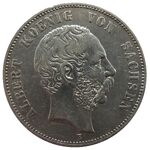
Coin of Albert.
The first Saxon 2 mark coin was issued in 1876[7], during the third year of King Albert's reign.[8] It had the standard composition, mass, and measurements of every other 2 gold mark coin issued in the states of the German Empire at the time, being composed of .900 fine silver, weighing 11.111 grams, and measuring 28 millimeters in diameter and 2 millimeters thick.[1] A right-facing portrait of Albert was engraved in the center of the coin's obverse, partially encircled by a caption reading "ALBERT KOENIG VON SACHSEN". Directly underneath the likeness of the king was an "E" mint mark[2][3], indicating the coin was struck at the Muldenhütten Mint.[9] The Reichsadler of the German Empire was displayed on the reverse, accompanied by the state title of the Second Reich (DEUTSCHES REICH), the coin's value, and the year.[1] Production of the coin ceased in 1888, but recommenced in 1891.[7] The only change made to the coin between the years was the design of the Reichsadler on the reverse. On the coins issued from 1876 to 1888, the heraldic eagle was rather small and bore a large shield on its breast. However, in 1891, the Reichsadler itself became larger and the shield became smaller.[9] The "large shield" coins were minted in 1876, 1877, 1879, 1880, 1883, and 1888. Between these years, at least 2,650,000 "large shield" examples were issued, with an unrecorded number being struck in proof quality.[2] The "small shield" coins were struck in 1891, 1893, 1895, 1896, and from 1899 to 1902, with a total mintage of at least 2,395,486. Some proof examples of the "small shield" coin were struck in 1902.[3]
Death of Albert coin[]
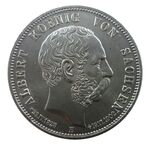
Death of Albert coin.
King Albert died in Sibyllenort, Saxony (now Szczodre, Poland) on June 19, 1902 at the age of 74.[8] In commemoration and respect for the deceased king, the Muldenhütten Mint struck a special 2 mark coin to mark the event. The same portrait of Albert used on the general issues emitted during his reign was displayed on the obverse, partially encircled by the original caption reading "ALBERT KOENIG VON SACHSEN". Underneath the likeness of the king were two inscriptions that read "⋆23.IV.1828" and "†19.VI.1902" separated by an "E" mint mark. These inscriptions respectively represented the dates of Albert's birth and death. The coin retained the composition, mass, measurements, and reverse design of the original issue of King Albert. A total of 167,875 examples were produced, with 250 being struck in proof quality.[10]
General issue of George[]
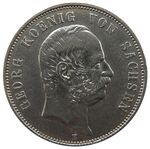
Coin of George.
Albert's younger brother, George, became King of Saxony on June 19, 1902, following the death of the former.[11] However, a coin featuring the new king's image was not issued until the first (and only) full year of his reign, 1903. A right-facing portrait of George was engraved on the obverse, accompanied by a legend reading "GEORG KOENIG VON SACHSEN" and an "E" mint mark. No changes were made regarding the original composition, mass, measurements, and reverse design of the second issue of Albert. This coin was only struck during 1903 and 1904, and between these years at least 2,011,134 examples were minted, with more than 50 of which being struck in proof quality.[4]
Death of George coin[]
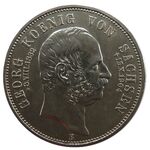
Death of George coin.
King George of Saxony died on October 15, 1904 at the Pillnitz quarter of Dresden at the age of 72, only about two years after his reign began.[11] In respect and commemoration of the king, the Muldenhütten Mint issued a coin to mark the event, similar to what they did on the date of King Albert's death a few years before. The portrait of George used on the general issue coinage emitted during his reign was featured on the obverse, accompanied by the original caption that accompanied it, "GEORG KOENIG VON SACHSEN", and an "E" mint mark. Additionally, two inscriptions flanked the likeness of King George, reading "⋆8.VII.1832" and "†15.X.1904", respectively indicating the dates of George's birth and death. Only 150,055 examples of this coin were produced, 55 of which were struck in proof quality.[12]
Coin of Frederick Augustus III[]
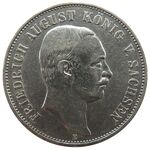
Coin of Frederick Augustus III.
Frederick Augustus III succeeded his father, George, as King of Saxony on October 15, 1904, as a result of the latter's death.[13] However, a coin featuring an image of the new king was not issued until 1905. It featured a right-facing image of Frederick Augustus III on the obverse, partially encircled by a caption reading "FRIEDRICH AUGUST KÖNIG V. SACHSEN". Underneath the likeness of the king was an "E" mint mark. The coin retained the original composition, mass, measurements, and reverse design of the general issue coinage that came before it since 1891. It was issued from 1905 to 1908, from 1911 to 1912, and again in 1914. Between these years, at least 3,217,884 2 mark coins of Frederick Augustus III were minted, with more than 100 of which being struck in proof quality.[5]
1909 commemorative coin[]
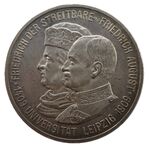
1909 commemorative coin.
The University of Leipzig was founded by Frederick I, Elector of Saxony and William II, Margrave of Meissen on December 2, 1409, after being officially endorsed by Antipope Alexander V.[14] Five hundred years later, in 1909, the institution became the subject of a commemorative Saxon 2 mark coin. A right-facing portrait of King Frederick Augustus III was engraved in the coin's foreground, and one of Elector Frederick I was displayed in the midground. Surrounding both images were two inscriptions reading "FRIEDRICH DER STREITBARE ~ FRIEDRICH AUGUST" and "1409 UNIVERSITÄT LEIPZIG 1909", separated from each other by two five-pointed stars (⋆). It had the same composition, mass, measurements, and reverse design as all the Saxon 2 mark coins that came before it since 1891. A total of 125,300 examples were minted, 300 of which were struck in proof quality.[6]
Medallic coinage[]
Kings Albert, George, and Frederick Augustus III all visited the Muldenhütten Mint during their lifetimes. Albert visited on July 16, 1892, George on May 7, 1903, and Frederick Augustus on April 6, 1905. During each of these years, the mint struck medallic 2 mark coins commemorating their visits, using the obverse design of the general issue coins minted during the reign of each respective king. They were struck in silver and measured 27 millimeters in diameter. The inscriptions on the reverse of the coin of Albert read "GEPRÄGT IN GEGENWART S.M. DES KÖNIGS" and "MÜNZSTÄTTE MULDNER HÜTTE D.16.JULI.1892". The inscriptions present on the reverse of the coin of George read virtually the same thing, but the "D.16.JULI.1892" was replaced with "D.7.MAI.1903".[7] Only one legend was present on the reverse of the coin of Frederick Augustus III, which read "ZUR ERINNERUNG AN DEN BESUCH SEINER MAJESTÄT DES KÖNIGS FRIEDRICH AUGUST AUF DER MULDNER HÜTTE AM 6. APRIL 1905".[15] The mintages of all three coins are unknown, but it was recorded that the Muldenhütten Mint issued proofs of each coin.[7]
References[]
| German gold mark | |
|---|---|
| Banknotes | 5 ℳ • 10 ℳ • 20 ℳ • 50 ℳ • 100 ℳ • 1000 ℳ |
| Coins | 1 ₰ • 2 ₰ • 5 ₰ • 10 ₰ • 20 ₰ • 25 ₰ • 50 ₰ • ½ ℳ • 1 ℳ • 2 ℳ • 3 ℳ • 5 ℳ • 10 ℳ • 20 ℳ |
| Miscellaneous | Bavarian Mint • Berlin State Mint • Coinage Act of 1873 • Darmstadt Mint • Dresden Mint • Frankfurt Mint • Hamburg Mint • Hannover Mint • Karlsruhe State Mint • Muldenhütten Mint • Reichsbank • Reichskassenschein • Stuttgart State Mint |
| 2 mark | Anhalt (Anhalt-Dessau) • Baden • Bavaria • Bremen • Hamburg • Hesse • Lippe • Lübeck • Mecklenburg-Schwerin • Mecklenburg-Strelitz • Oldenburg • Prussia • Reuss Elder Line (Reuss-Obergreiz) • Reuss Younger Line (Reuss-Schleiz) • Saxe-Altenburg • Saxe-Coburg-Gotha • Saxe-Meiningen • Saxe-Weimar-Eisenach • Saxony (Saxony-Albertine) • Schaumburg-Lippe • Schwarzburg-Rudolstadt • Schwarzburg-Sondershausen • Württemberg |
|---|---|
| 3 mark | Anhalt • Baden • Bavaria • Brunswick • Hamburg • Hesse • Lippe • Lübeck • Mecklenburg-Schwerin • Mecklenburg-Strelitz • Prussia • Reuss Elder Line • Saxe-Meiningen • Saxe-Weimar-Eisenach • Saxony • Schaumburg-Lippe • Schwarzburg-Sondershausen • Württemberg |
| 5 mark | Anhalt • Baden • Bavaria • Bremen • Brunswick • Hamburg • Hesse • Lübeck • Mecklenburg-Schwerin • Oldenburg • Prussia • Saxe-Altenburg • Saxe-Coburg-Gotha • Saxe-Meiningen • Saxe-Weimar-Eisenach • Saxony • Schaumburg-Lippe • Waldeck-Pyrmont • Württemberg |
| 10 mark | Anhalt • Baden • Bavaria • Bremen • Hamburg • Hesse • Lübeck • Mecklenburg-Schwerin • Mecklenburg-Strelitz • Oldenburg • Prussia • Reuss Younger Line • Saxe-Coburg-Gotha • Saxe-Meiningen • Saxony • Schwarzburg-Rudolstadt • Württemberg |
| 20 mark | Anhalt • Baden • Bavaria • Bremen • Brunswick • Hamburg • Hesse • Mecklenburg-Schwerin • Mecklenburg-Strelitz • Prussia • Reuss Elder Line • Reuss Younger Line • Saxe-Altenburg • Saxe-Coburg-Gotha • Saxe-Meiningen • Saxe-Weimar-Eisenach • Saxony • Schaumburg-Lippe • Schwarzburg-Sondershausen • Waldeck-Pyrmont • Württemberg |
